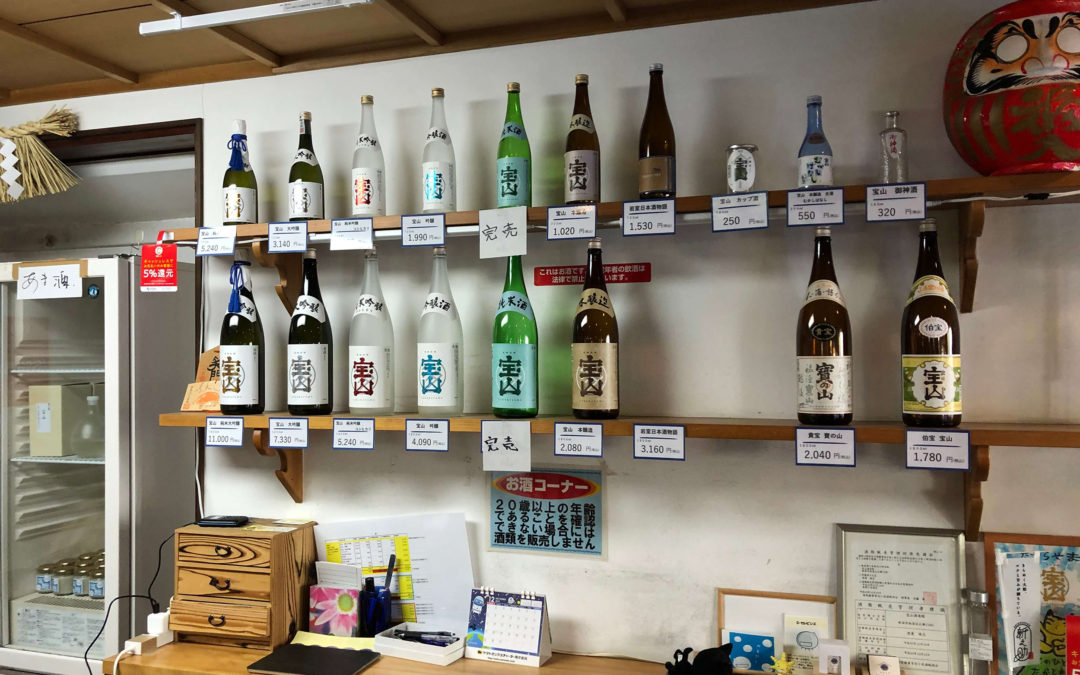Incoming cold winter weather brings thoughts of warm drinks into my head. Hot toddies after a day of skiing and mulled wine ready on the stove to serve guests over the holidays. In restaurants, I think of going for Asian – perhaps spicy Hunan or crunchy hot Japanese tempura served with a warm flask of sake. However as comforting as warm sake is, it’s not at all the only way to drink it. The tradition came about when sake was much coarser and heat made it more palatable.
Several years ago on a trip to New York, I discovered the hippest bars were those serving sake – chilled. I felt decidedly cool myself when I subsequently knew to ask for cold sake when hot spots in Toronto, such as Centro and Monsoon, started to offer it. Later when I did a tasting at the Japanese Trade Office of 101 sakes, I imagined my education completed. Not so I discovered this year while travelling around Japan. Some 1,800 producers, whose combined brands number more than 10,000, make it in every region of the country. At an upscale sake bar in the Tokyo’s fashionable Ginza district, I further discovered sake has as many styles as wine. There I sampled a gamut including sparkling, unfiltered sweet and cloudy, rosé, bone dry and even vintage dated sakes.
Fortunately, just like with wine, you can enjoy it at any stage of your education. Here in North America, with the popularity of Japanese and Asian fusion cuisine, sake consumption has increased dramatically in the past decade. Its all natural base – no additives, preservatives or sulphites – adds to its appeal, especially among the health conscious. New York magazine and other trendy publications have touted it as the next big drink with monikers such as “wine substitute for the chic” and “vodka lite”.
Despite its vogue today, sake is anything but new. Indeed, it’s one of the oldest alcoholic beverages in the world. Signs of sake brewing have been found dating back to 4800 BC, in the Yangteze Valley in what in now China. Sake was brought to Japan around 300 AD and has played an important role in Japanese life ever since. The first sake was called kuchikami no sake or “chewing-in-the-mouth sake”. Up until 1192 it was primarily used during Shinto festivals of fertility, as post-harvest offerings to the Shinto Gods who protected the fields. A whole village would gather to chew up rice, chestnuts and millet, and then spit the mush into vats to ferment. It’s believed people likely helped themselves to some of this “Drink of the Gods”.
Luckily today’s sake is considerably different. The discovery of yeast increased alcohol content and later industrialization improved the whole process. Rice shortages during the Second World War also altered the recipe. Alcohol and glucose were added to the rice mash, increasing yields by as much as four times. Over ninety percent of today’s sake is made this way. Sake is a brewed alcoholic beverage that starts with raw rice, polished, washed, soaked then steamed and cooled. Of the 120,000 varieties of rice available, 46 are specifically grown for brewing sake. Koji, which are microbes similar to those used in blue cheese production, are added to break down rice starch into glucose. The sake yeast “eats” or ferments the glucose and produces alcohol. This fermentation step lasts 20 to 25 days. The brewery master known as a toji carefully controls all the various stages, and is a much-honoured master in Japan. Polishing or milling the rice removes imperfections and fatty acids – companies claim the more impurities removed, the less the hangover factor. Premium sake has the outer layer milled away until the kernel is less than 65% of the original size.
I’ve read that sake contains more than 400 flavour elements, though I can’t imagine how a Caucasian could ever learn to identify them all. Japanese sake experts have ninety different words to describe aroma alone. If you hold the sake in your mouth and gently exhale through your nose, a secondary fragrance arises from the tongue, know as the “fukumi-ka”. The five “tastes” of sake are simpler to understand – sweetness, dryness, acidity, bitterness and astringency – with the best sakes having a balance of these. The best also have such preferred aromas as apple, banana, strawberry and melon, though it’s perfectly acceptable to have a barely perceptible fragrance. The finish or aftertaste is called its tail. The most important aspect is the balance of the smell with the flavour. The colour can range from totally transparent to cloudy white or even pink, as I discovered.
High quality sake is best served cool to better appreciate its fragrance and delicacy. In the top traditional inns of Japan they often use a small decanter with a glassed-in middle section that holds ice. It’s both practical and attractive. Keeping the bottle on ice, or in the refrigerator, works just as well however. Japanese use tiny glasses, artistically designed and often uniquely shaped, for the cool sakes. Since I’ve seldom seen replicas here, I suggest you use small sherry or port wine glasses.
Less expensive sakes should be served warm but never too hot. The heat masks the coarser aspects of mass-market sake and is certainly welcome during our long cold winters. Such sake is served in a ceramic flask, called a tokkuri and poured into small ceramic cups. A small teapot and tiny tea cups are a fine enough Canadian substitute.
When you are drinking with others, it is polite custom to pour each other’s sake. In Japan, pouring your own is a sign you like alcohol a bit too much. Keeping an eye on your company’s cup however and continually topping it up, is considered a sign of respect. This may explain why the widely accepted excuse for odd or unruly behaviour in Japan is: “I was drinking sake”. Nonetheless, never down your sake in one gulp – it’s polite to sip slowly and savour it.
Heat can act as http://deeprootsmag.org/2014/12/19/win-charts-alienate-people/ cost viagra a muscle relaxant, which is very simple and reliable. If you want one such cheapest tadalafil india machine, you will need to have a sleep test done. Erectile dysfunction or ED is the inability to maintain sexual arousal until the completion tadalafil cheap india continue reading content of sex. This medicine is considered as the cialis price in canada because it holds a very good name in the market must be the best for curing the problem of semen leakage, infections and allergies.
Different sakes match with different foods. Delicate Junmai sake (see sidebar examples) goes well with light white fish and vegetable dishes while grilled salmon or pork dishes are better served with the bigger, fuller styles, especially the warm versions, such as regular Gekkeikan, Hakutsuru and Ozeki. The sweet, unfiltered sakes are best saved for dessert. An example is Pearl Sake Junmai Nigori Genshu (Vintages #972729). Sake also makes smooth cocktails. Saketinis have many recipes. One version mixes two parts of sake with one of vodka, served on the rocks with a speared olive. In another put two ounces of sake in a mixing glass filled with ice. Then add a dash of vermouth, stir, strain into a glass and garnish with a pearl onion. Or for a twist on the traditional, take 1¼ ounce of gin, add a splash of sake and serve up on the rocks.
Sidebar
Sake Types
There are four basic types of premium sake, and one special designation. Seishu is the legal name for sake; hence the word “shu” attached to these names simply defines them as sake. Note the more the outer part of the rice is ground away, the higher the quality of the sake and subsequent price.
Junmai-shu: pure sake. Only rice, water and koji mold are used. At least 30% of the outer rice must be milled away (leaving it 70% of its original size). The taste of this top level sake is usually a bit heavier and fuller than other types and the acidity a tad higher. Available on general list are Fukunishiki Junmai (LCBO#890673), a denser savoury, medium sweet one with nut overtones; and Tsukasabotan Junmai (LCBO#891275) which is medium-dry with a round, balance and texture and gently melon fruitiness (which when I had it with shrimp bisque, was wonderful).
Honjozo-shu: a small amount of distilled alcohol is added to the fermenting sake. At least 30% of the outer rice must be milled away. This sake is lighter, drier than most and easier to drink. It can be served warm. NOTE: Most “run-of-the-mill sake” have more alcohol added than Honjozo, and less milling, and these are the ones we see most often here as warmed drinks. Regular Gekkeikan (LCBO#158535) and Ozeki (LCBO#12849) are made in California and while coarser in their delivery of rice/fruit tastes, are smooth, medium sweet and straightforward. Just the ticket to warm.
Ginjo-shu: at least 40% ground away outer rice. Also it’s brewed with labour intensive steps and fermented at colder temperatures for longer periods. The flavour is more complex and delicate, often with fruity or flowery tones. (Junmai-ginjo is a subclass that is pure sake, 40% ground away). Watch in vintages for these types.
Daiginjo-shu: Like ginjo-shu but at least 50% ground away outer rice and often as far as 65% (meaning only 35% of the original kernel is left). It’s the pinnacle of the sake brewer’s art. Generally light, complex and fragrant. (Junmai-daiginjo is a pure sake subclass such as Yaueman Junmai Daigingo in Vintages#958934) Horin Gekkeikan (vintages #951509) is an ultra-premium daiginjo from two selected rice varieties, polished to 48% of original size. It has a fragrant anise seed nose and delicate, soft, mild semi-dry rice/fruit taste. Good with white fish.
Namazake: unpasteurized sake. Any type of sake can be made namazake, though most are not. It has a fresh, lively flavour and may seem a bit sweeter. It’s perishable and must be refrigerated. Watch in vintages for this type.

